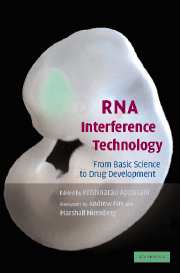Book contents
- Frontmatter
- Contents
- Foreword by Andrew Fire
- Foreword by Marshall Nirenberg
- List of Contributors
- Introduction
- Section one Basic RNAi, siRNA, microRNAs and gene-silencing mechanisms
- Section two Design, synthesis of siRNAs
- Section three Vector development and in vivo, in vitro and in ovo delivery methods
- 10 Six methods of inducing RNAi in mammalian cells
- 11 Viral delivery of shRNA
- 12 siRNA delivery by lentiviral vectors: Design and applications
- 13 Liposomal delivery of siRNAs in mice
- 14 Chemical modifications to achieve increased stability and sensitive detection of siRNA
- 15 RNA interference in postimplantation mouse embryos
- 16 In ovo RNAi opens new possibilities for functional genomics in vertebrates
- Section four Gene silencing in model organisms
- Section five Drug target validation
- Section six Therapeutic and drug development
- Section seven High-throughput genome-wide RNAi analysis
- Index
- Plate section
- References
13 - Liposomal delivery of siRNAs in mice
Published online by Cambridge University Press: 31 July 2009
- Frontmatter
- Contents
- Foreword by Andrew Fire
- Foreword by Marshall Nirenberg
- List of Contributors
- Introduction
- Section one Basic RNAi, siRNA, microRNAs and gene-silencing mechanisms
- Section two Design, synthesis of siRNAs
- Section three Vector development and in vivo, in vitro and in ovo delivery methods
- 10 Six methods of inducing RNAi in mammalian cells
- 11 Viral delivery of shRNA
- 12 siRNA delivery by lentiviral vectors: Design and applications
- 13 Liposomal delivery of siRNAs in mice
- 14 Chemical modifications to achieve increased stability and sensitive detection of siRNA
- 15 RNA interference in postimplantation mouse embryos
- 16 In ovo RNAi opens new possibilities for functional genomics in vertebrates
- Section four Gene silencing in model organisms
- Section five Drug target validation
- Section six Therapeutic and drug development
- Section seven High-throughput genome-wide RNAi analysis
- Index
- Plate section
- References
Summary
Introduction
Novel tools for evaluating gene function in vivo such as ribozymes and RNA interference (RNAi) are emerging as the most highly effective strategies (Sioud, 2001; Sioud, 2004; Hannon, 2002). RNAi is sequence-specific posttranscriptional gene silencing, which is triggered by double stranded RNA (dsRNA). This evolutionally conserved gene-silencing pathway triggered by dsRNAs was first described in the nematode worm Caenorhabditis elegans (Fire et al., 1998). This process has been linked to many previously described phenomena such as post-transcriptional gene silencing (PTGS) in plants (Jorgensen, 1990). The difficulty of using RNAi in somatic mammalian cells was overcome when Tuschl and colleagues discovered that siRNAs (21 nt), normally generated from long dsRNA during RNAi, could be used to inhibit specific gene targets (Elbashir et al., 2001). Currently, there is a great interest in the use of small interfering RNA as a research tool to study gene function and drug target validation (Dykxhoorn et al., 2003; Sørensen et al., 2003).
The therapeutic application of siRNAs, however, is largely dependent on the development of a delivery vehicle that can efficiently deliver the siRNAs to target cells. In addition, such delivery vehicles should be administered efficiently, safely and repeatedly. Cationic liposomes represent one of the few examples that can meet these requirements (Templeton, 2002). These agents are composed of positively charged lipid bilayers, and can be complexed to negatively charged siRNA duplexes. The routes of delivery include direct injection (e.g. intratumoral), intravenous, intraperitoneal, intraarterial, intracranial, and others.
- Type
- Chapter
- Information
- RNA Interference TechnologyFrom Basic Science to Drug Development, pp. 186 - 193Publisher: Cambridge University PressPrint publication year: 2005



